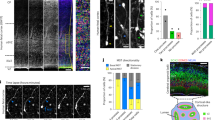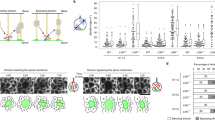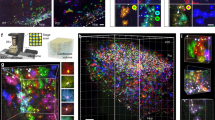Abstract
Neurons in the developing rodent cortex are generated from radial glial cells that function as neural stem cells. These epithelial cells line the cerebral ventricles and generate intermediate progenitor cells that migrate into the subventricular zone (SVZ) and proliferate to increase neuronal number. The developing human SVZ has a massively expanded outer region (OSVZ) thought to contribute to cortical size and complexity. However, OSVZ progenitor cell types and their contribution to neurogenesis are not well understood. Here we show that large numbers of radial glia-like cells and intermediate progenitor cells populate the human OSVZ. We find that OSVZ radial glia-like cells have a long basal process but, surprisingly, are non-epithelial as they lack contact with the ventricular surface. Using real-time imaging and clonal analysis, we demonstrate that these cells can undergo proliferative divisions and self-renewing asymmetric divisions to generate neuronal progenitor cells that can proliferate further. We also show that inhibition of Notch signalling in OSVZ progenitor cells induces their neuronal differentiation. The establishment of non-ventricular radial glia-like cells may have been a critical evolutionary advance underlying increased cortical size and complexity in the human brain.
This is a preview of subscription content, access via your institution
Access options
Subscribe to this journal
Receive 51 print issues and online access
$199.00 per year
only $3.90 per issue
Buy this article
- Purchase on Springer Link
- Instant access to full article PDF
Prices may be subject to local taxes which are calculated during checkout





Similar content being viewed by others
Change history
25 March 2010
Fig. 4 was changed to double column on 25 March 2010.
References
Smart, I. H. Proliferative characteristics of the ependymal layer during the early development of the mouse neocortex: a pilot study based on recording the number, location and plane of cleavage of mitotic figures. J. Anat. 116, 67–91 (1973)
Malatesta, P., Hartfuss, E. & Gotz, M. Isolation of radial glial cells by fluorescent-activated cell sorting reveals a neuronal lineage. Development 127, 5253–5263 (2000)
Miyata, T., Kawaguchi, A., Okano, H. & Ogawa, M. Asymmetric inheritance of radial glial fibers by cortical neurons. Neuron 31, 727–741 (2001)
Noctor, S. C., Flint, A. C., Weissman, T. A., Dammerman, R. S. & Kriegstein, A. R. Neurons derived from radial glial cells establish radial units in neocortex. Nature 409, 714–720 (2001)
Haubensak, W., Attardo, A., Denk, W. & Huttner, W. B. Neurons arise in the basal neuroepithelium of the early mammalian telencephalon: a major site of neurogenesis. Proc. Natl Acad. Sci. USA 101, 3196–3201 (2004)
Noctor, S. C., Martinez-Cerdeno, V., Ivic, L. & Kriegstein, A. R. Cortical neurons arise in symmetric and asymmetric division zones and migrate through specific phases. Nature Neurosci. 7, 136–144 (2004)
Smart, I. H., Dehay, C., Giroud, P., Berland, M. & Kennedy, H. Unique morphological features of the proliferative zones and postmitotic compartments of the neural epithelium giving rise to striate and extrastriate cortex in the monkey. Cereb. Cortex 12, 37–53 (2002)
Zecevic, N., Chen, Y. & Filipovic, R. Contributions of cortical subventricular zone to the development of the human cerebral cortex. J. Comp. Neurol. 491, 109–122 (2005)
Fish, J. L., Dehay, C., Kennedy, H. & Huttner, W. B. Making bigger brains-the evolution of neural-progenitor-cell division. J. Cell Sci. 121, 2783–2793 (2008)
Rakic, P. Neurons in rhesus monkey visual cortex: systematic relation between time of origin and eventual disposition. Science 183, 425–427 (1974)
Lukaszewicz, A. et al. G1 phase regulation, area-specific cell cycle control, and cytoarchitectonics in the primate cortex. Neuron 47, 353–364 (2005)
Bayatti, N. et al. A molecular neuroanatomical study of the developing human neocortex from 8 to 17 postconceptional weeks revealing the early differentiation of the subplate and subventricular zone. Cereb. Cortex 18, 1536–1548 (2008)
Mo, Z. & Zecevic, N. Is Pax6 critical for neurogenesis in the human fetal brain? Cereb. Cortex 18, 1455–1465 (2008)
Götz, M., Stoykova, A. & Gruss, P. Pax6 controls radial glia differentiation in the cerebral cortex. Neuron 21, 1031–1044 (1998)
Haas, K., Sin, W. C., Javaherian, A., Li, Z. & Cline, H. T. Single-cell electroporation for gene transfer in vivo . Neuron 29, 583–591 (2001)
Weissman, T., Noctor, S. C., Clinton, B. K., Honig, L. S. & Kriegstein, A. R. Neurogenic radial glial cells in reptile, rodent and human: from mitosis to migration. Cereb. Cortex 13, 550–559 (2003)
Rakic, P. Developmental and evolutionary adaptations of cortical radial glia. Cereb. Cortex 13, 541–549 (2003)
Rakic, P. Specification of cerebral cortical areas. Science 241, 170–176 (1988)
Gan, W. B., Grutzendler, J., Wong, W. T., Wong, R. O. & Lichtman, J. W. Multicolor “DiOlistic” labeling of the nervous system using lipophilic dye combinations. Neuron 27, 219–225 (2000)
Chenn, A., Zhang, Y. A., Chang, B. T. & McConnell, S. K. Intrinsic polarity of mammalian neuroepithelial cells. Mol. Cell. Neurosci. 11, 183–193 (1998)
Letinic, K., Zoncu, R. & Rakic, P. Origin of GABAergic neurons in the human neocortex. Nature 417, 645–649 (2002)
Englund, C. et al. Pax6, Tbr2, and Tbr1 are expressed sequentially by radial glia, intermediate progenitor cells, and postmitotic neurons in developing neocortex. J. Neurosci. 25, 247–251 (2005)
Kowalczyk, T. et al. Intermediate neuronal progenitors (basal progenitors) produce pyramidal-projection neurons for all layers of cerebral cortex. Cereb. Cortex 19, 2439–2450 (2009)
Sessa, A., Mao, C. A., Hadjantonakis, A. K., Klein, W. H. & Broccoli, V. TBR2 directs conversion of radial glia into basal precursors and guides neuronal amplification by indirect neurogenesis in the developing neocortex. Neuron 60, 56–69 (2008)
Petanjek, Z., Berger, B. & Esclapez, M. Origins of cortical GABAergic neurons in the cynomolgus monkey. Cereb. Cortex 19, 249–262 (2009)
Götz, M. & Huttner, W. B. The cell biology of neurogenesis. Nature Rev. Mol. Cell Biol. 6, 777–788 (2005)
Gaiano, N., Nye, J. S. & Fishell, G. Radial glial identity is promoted by Notch1 signaling in the murine forebrain. Neuron 26, 395–404 (2000)
Shimojo, H., Ohtsuka, T. & Kageyama, R. Oscillations in Notch signaling regulate maintenance of neural progenitors. Neuron 58, 52–64 (2008)
Abdel-Mannan, O., Cheung, A. F. & Molnar, Z. Evolution of cortical neurogenesis. Brain Res. Bull. 75, 398–404 (2008)
Rakic, P. & Sidman, R. L. Supravital DNA synthesis in the developing human and mouse brain. J. Neuropathol. Exp. Neurol. 27, 240–276 (1968)
Choi, B. H. Glial fibrillary acidic protein in radial glia of early human fetal cerebrum: a light and electron microscopic immunoperoxidase study. J. Neuropathol. Exp. Neurol. 45, 408–418 (1986)
Schmechel, D. E. & Rakic, P. Arrested proliferation of radial glial cells during midgestation in rhesus monkey. Nature 277, 303–305 (1979)
Schmechel, D. E. & Rakic, P. A Golgi study of radial glial cells in developing monkey telencephalon: morphogenesis and transformation into astrocytes. Anat. Embryol. (Berl.) 156, 115–152 (1979)
Kriegstein, A., Noctor, S. & Martinez-Cerdeno, V. Patterns of neural stem and progenitor cell division may underlie evolutionary cortical expansion. Nature Rev. Neurosci. 7, 883–890 (2006)
Baek, J. H., Hatakeyama, J., Sakamoto, S., Ohtsuka, T. & Kageyama, R. Persistent and high levels of Hes1 expression regulate boundary formation in the developing central nervous system. Development 133, 2467–2476 (2006)
Acknowledgements
We thank A. Alvarez-Buylla, D. Rowitch and Kriegstein laboratory members for ideas arising from discussions and for critical reading of the manuscript. We thank A. Javaherian for help setting up the conditions for dye electroporation, T. Weissman for advice on ‘DiOlistics’, Z. Mirzadeh for expertise with whole-mount staining, C. Harwell for retroviral production, and W. Walantus, J. Agudelo, L. Fuentealba, O. Genbacev, M. Donne and S. Kaing for other technical support. We thank R. Kageyama for his gift of the HES1 antibody35, and F. Gage for GFP-retrovirus reagents. We thank the staff at San Francisco General Hospital for providing access to donated fetal tissue. Artwork in Fig. 5e is by K. X. Probst (Xavier Studio). This work was supported by grants from the California Institute for Regenerative Medicine and the Bernard Osher Foundation. J.H.L. is funded by a CIRM Predoctoral Fellowship.
Author Contributions D.V.H. and J.H.L. (listed alphabetically) carried out all the experiments except for the electrophysiology, analysed the data, and wrote the manuscript. P.R.L.P. performed the electrophysiology and analysed data. A.R.K., as the principal investigator, provided conceptual and technical guidance for all aspects of the project. All authors discussed the results/experiments and revised/edited the manuscript.
Author information
Authors and Affiliations
Corresponding author
Ethics declarations
Competing interests
The authors declare no competing financial interests.
Supplementary information
Supplementary Information
This file contains Supplementary Figures 1-14 with Legends and Legends for Supplementary Movies 1-4. (PDF 28812 kb)
Supplementary Movie 1
This movie shows multiple examples of mitotic somal translocation and oRG (OSVZ radial glia-like) cell division. Imaging for ~20 h at 20-min intervals - see Supplementary Information file for full legend. (MOV 5651 kb)
Supplementary Movie 2
This movie shows an oRG cell division highlighting mitotic somal translocation, followed by division of intermediate progenitor daughter. Imaging for ~46 h at 22-min intervals. Cell divisions are at t=12:18 and t=45:46 - see Supplementary Information file for full legend. (MOV 4955 kb)
Supplementary Movie 3
This movie shows an oRG cell that divides and self-renews twice. Imaging for ~56 h at 22-min intervals. Cell divisions are at t=0:44 and t=44:38 - see Supplementary Information file for full legend. (MOV 7008 kb)
Supplementary Movie 4
This movie shows an oRG cell undergo two self-renewing divisions followed by an intermediate progenitor daughter cell division. Imaging for ~57 h at 22-min intervals. Cell divisions are at t=5:30, t=43:32, and t=46:50 - see Supplementary Information file for full legend. (MOV 6139 kb)
Rights and permissions
About this article
Cite this article
Hansen, D., Lui, J., Parker, P. et al. Neurogenic radial glia in the outer subventricular zone of human neocortex. Nature 464, 554–561 (2010). https://doi.org/10.1038/nature08845
Received:
Revised:
Accepted:
Published:
Issue Date:
DOI: https://doi.org/10.1038/nature08845
This article is cited by
-
Genetics of human brain development
Nature Reviews Genetics (2024)
-
CUL4B mutations impair human cortical neurogenesis through PP2A-dependent inhibition of AKT and ERK
Cell Death & Disease (2024)
-
A cell fate decision map reveals abundant direct neurogenesis bypassing intermediate progenitors in the human developing neocortex
Nature Cell Biology (2024)
-
A beginner’s guide on the use of brain organoids for neuroscientists: a systematic review
Stem Cell Research & Therapy (2023)
-
Neocortex neurogenesis and maturation in the African greater cane rat
Neural Development (2023)
Comments
By submitting a comment you agree to abide by our Terms and Community Guidelines. If you find something abusive or that does not comply with our terms or guidelines please flag it as inappropriate.



